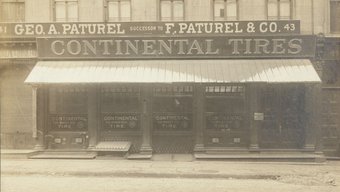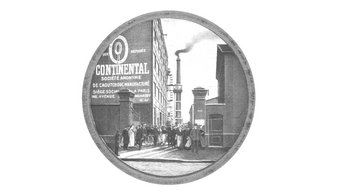Continental as a global company. The long road towards internationalization
Continental’s export focus and international orientation have progressed successfully from its earliest times, as was already demonstrated in the first years and decades of its company history. At an early stage, the management set itself the goal of supplying innovative products made from soft rubber to other European and non-European countries, far beyond Hanover and Germany. Serving as commercial director from 1879 to 1925, Siegmund Seligmann laid the foundations for Continental’s rise from a small rubber factory in Hanover to an internationally active technology group. These days, with over 500 locations in 58 countries and markets, Continental is more internationally positioned than ever.
150 years of Continental as a global company
“The [Continental] name, which has been unchanged since 1871, was chosen as an absolutely international name that would allow Continental to use the same name wherever it might be doing business, whether in France, Italy, Russia or overseas.” This quote comes from a letter from Continental director Siegmund Seligmann dated January 11, 1915 and illustrates just how much Continental was already looking to the future internationalization of the company when it was newly founded. Writing this letter in the middle of the First World War, Seligmann saw himself called upon to explain the origin and meaning of the company name. Some dissenting voices said that “Continental” sounded foreign and needed to be made “more German.”
In the end, however, all nationalistically motivated attempts to force Continental to change its name came to nothing. A more Germanic version of the company name would have been put of the question at an early stage, as Continental did much of its business abroad. Back in 1913, foreign business accounted for almost 50 percent of total sales.
Internationalization around the First and Second World War
It is not known when exactly Continental exported its first product. However, the company was already pushing forward with the expansion of its export business around 1881. With pneumatic tires for bicycles in 1892, followed by automobile tires in 1898, Continental was manufacturing products that were competitive in other markets.
In the early days of its company’s history, Continental could not point to many groundbreaking inventions. Instead the company enjoyed greater success in industrializing and perfecting new technologies. Executive Board members Siegmund Seligmann and Adolf Prinzhorn in particular openly cooperated with international competitors, sharing know-how and acquiring valuable strategic licenses. This openness to other inventions and innovative developments paved the way for Continental’s rise and diversification, expanding its range from initially simple consumer goods from rubber to tires to highly specialized technical and promotional products.
Despite the sometimes significant customs barriers, Continental succeeded in establishing an international network of branches. It set about organizing local sales and marketing organizations. From 1904, several of these subsidiaries were upgraded to incorporated companies, as a way of increasing their ability to act locally, and ultimately making the brand more visible in the various markets. Before the outbreak of the First World War, Continental had a network of 110 subsidiaries in 53 countries.
The First World War marked a major setback in the internationalization of Continental’s business. When the company took stock in 1924/25 and compared its sales with the pre-war period of 1913/14, the results were shocking: sales had declined by more than 95 percent in Italy, by more than 92 percent in France and more than 70 percent in Spain. Despite all its efforts, Continental struggled to regain the position established abroad before the First World War.
After years of hyperinflation and economic crises, economic conditions finally improved, but Hitler’s rise to power in January 1933 faced the Continental Executive Board once again with a regime that totally rejected internationalism. The only success was a tire factory in Torrelavega in Spain, built in spring 1936. This gave Continental its own factory abroad for the first time since 1914. Even so, just a few months after production started, the project came to a halt when Torrelavega was occupied in the Spanish Civil War, and contact with Hanover was broken off for more than a year and a half.
In the aftermath of the First World War, the company’s foreign network had largely collapsed, knocking Continental’s development back by many years. In 1913, exports accounted for 54.5 percent of Continental’s total turnover, but in 1926, the figure lay at just 17 percent. In 1934, exports accounted for 9.1 percent of total turnover, and by 1938 this had fallen to just 5.4 percent. The Second World War also impacted on the foreign network and caused it to collapse. Consequently, Continental focused on the domestic market in the following years. After the end of the Second World War, however, the company was confronted with increasing competition at home. Concentration on domestic business lasted until the mid-1960s.
The four major internationalization phases after the Second World War
The first internationalization phase
Carl H. Hahn became the new chairman of the Executive Board in April 1973. Not only did he preside over a hard phase of restructuring, but also chose a different strategy for internationalization from his predecessors. The general conditions that applied in the post-war era meant that it was out of the question for the company to build up its own plants, however Hahn nevertheless took a daring step forward: a cooperation agreement with US tire company Uniroyal was signed in 1974. The agreement was part of a restructuring plan initiated by Hahn that would bring the company into the future and help it catch up quickly on technological deficits. In 1979, Continental took over Uniroyal’s entire European business. The news came as a sensation and heralded the start of the first internationalization phase since the Second World War.
Before this, Continental had fought for economic survival for years and had sustained major losses. There were even discussions about whether it should get out of the tire business completely. Now, however, the company, which has become very national in character, once again transformed itself into a European corporation. The takeover of Uniroyal’s European business was supplemented by a series of further cooperation ventures with competitors. Collaboration followed a similar pattern: Continental provided the technical expertise and thus acquired greater production capacity and sales channels in the respective countries. Despite the company’s lack of resources, this pragmatic approach enabled Continental to independently tap into new markets and set the course for a successful future. In 1979, the foreign share of consolidated sales amounted to an impressive 35 percent.
The second internationalization phase
From 1979, Continental continued to drive internationalization forward on a massive scale. The second internationalization phase after the Second World War began. The final breakthrough to becoming an international and now global company took place in 1987 with the takeover of General Tire in Akron, Ohio. Since 2001 the latter has been operating under the name Continental Tire North America, Inc. Continental’s production network was suddenly expanded by six plants in the USA, as well as production sites in Canada, Morocco and Mexico. The foreign share of company turnover now lay at 65 percent, reaching the level of 1913, the highest previous level of internationalization, after 75 years.
By the end of 1988, more than half of Continental’s employees worked outside Germany, a first in company history. As a result of the company’s expansion, Continental needed to find a common basis for cooperation and consider its own corporate culture and identity. This played a major role in its modernization and future viability. In this phase Semperit (1985), Gislaved (1990), and Barum (1993) expanded not only the tire portfolio but also Continental’s international production network.
The third internationalization phase
In a third internationalization phase from the start of the 2000s, production capacities were increasingly relocated to Eastern Europe. This process had already begun in the 1990s and was now intensified. After the Cold War, Continental entered into various cooperation agreements with local manufacturers in order to secure a share in the new markets that were opening up. The locations Otrokovice (Czech Republic), Púchov (Slovakia) and Timişoara (Romania) expanded Continental’s production network, and today these are by far the Group’s largest tire plants. More German and international companies joined the Continental Group in quick succession. The acquisition of Phoenix (2004) and Veyance (2015) transformed the ContiTech business area, founded in 1988, into one of the world’s largest specialists in rubber and plastics technologies.
Since the early 1990s, Continental had pursued an intensive diversification strategy. The objective was to develop from being just a manufacturer of rubber and plastic products into being a broadly positioned system supplier.The acquisition of Teves (1998), Temic (2001) and especially Siemens VDO (2007) turned Continental into a comprehensively globalized company with plants and sales locations in all parts of the world. These made Asian sites part of the Group. In 2000, foreign business accounted for 70.4 percent of consolidated sales.
The fourth internationalization phase
A fourth internationalization phase in 2010 following the global economic and financial crisis saw a significant speeding up of expansion into Asia. At this time, the company already had its own or jointly operated plants in Australia, China, India, Indonesia, Japan, Malaysia, the Philippines, Sri Lanka, South Korea and Thailand. As chairman of the Executive Board, Elmar Degenhart once again pushed forward with expansion in Asia.
Now numbering over 500 locations in 58 countries and markets, Continental is more internationally positioned than ever. The Group’s international sales climbed from 72.8 percent (2010) to 82 percent (2020). In the 2020 business year, 24 percent of sales were generated in Asia, 25 percent in North America, and 30 percent in Europe.
Conclusion
Continental’s development from a small Hanover-based rubber factory into a global technology group shows that the company has successfully progressed its international expansion despite the economic setbacks associated with the First and Second World Wars. Since Continental’s founding, internationalization has been firmly embedded in its DNA and continues to be a key driver for the company to this day.












